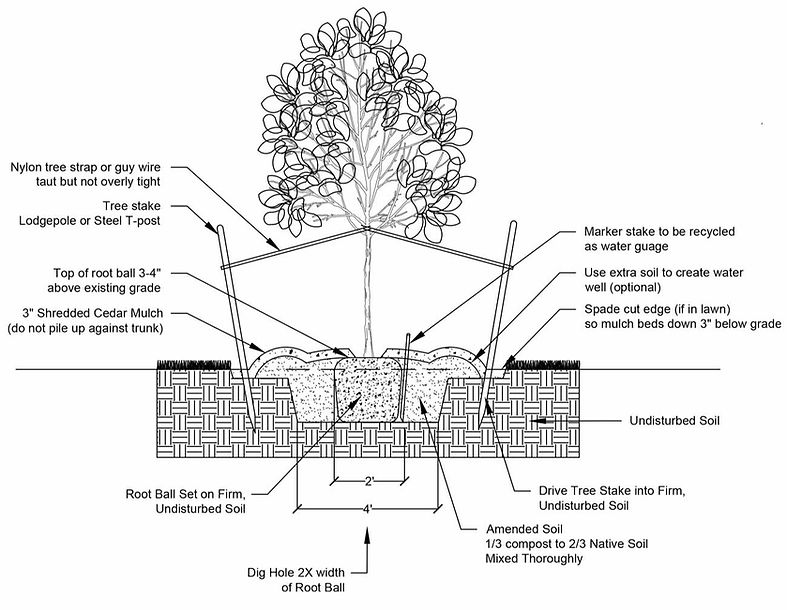
Tree and Shrub Planting Guide for Colorado
Your trees cannot be planted within 18” of any marked utility. Call 811 for free utility marking.
1) Dig a hole twice as wide as the width of your tree’s root ball or container (ex. root ball is 2’ wide, dig a 4’ wide hole).
The tree should be planted with the top of the root ball 3-4” above the level of the ground (ex. root ball is 24” tall, dig a hole only 20” deep). The tree should be set on firm undisturbed soil.
Planting in lawn? Remove a ring of turf twice as wide as your tree’s root ball and discard or toss it in the compost pile.
Planting in a mulch or rock garden bed? Remove and stockpile the mulch. Give yourself plenty of space around the hole so mulch or rock doesn’t fall into your planting hole. Shovel your excavated soil onto a tarp or wheelbarrow so it doesn’t mix with your mulch or rock. Cut a large “X” through your weed barrier fabric (if it’s there) and tuck in the corners so you can dig your hole.
If your tree is in a container or plastic bucket remove it at this time. Gently slide the root mass out of the container or cut the bucket off the tree. Balled and Burlapped trees should left intact until the tree is set in place.
2) Gently roll your tree into the center of the planting hole. If you have enough help you can lift the tree by the root ball and gently set the tree into the hole. Take care not to yank or wrench the tree into position by the trunk. All positioning should be done by pulling on the ropes or wire basket around the root ball.
Using the ropes or wire basket around the root ball, rotate the tree into the desired position and set upright. Do not crank on the trunk or branches of the tree to stand it up! Use a little soil at the base of the root ball to prop up your tree and hold it upright.
Amend your excavated soil with the compost, soil pep or soil conditioner, we have had the best success with a 50/50 mix of soil pep and soil conditioner. Use about 1/3 the volume of compost to 2/3 excavated soil. Mix the compost into your soil as best as possible. Break up any clods of dirt with your shovel.
3)Fill the hole around your tree about ½ way with your amended soil. Water thoroughly, using your garden hose to settle the soil around the root ball. Do not tamp or pack the soil around the roots.
Cut the top half of the wire basket off of the root ball and remove it. Cut and remove as much of the burlap as possible, taking care not to disrupt the ball of soil around the roots.
Fill the remainder of the hole with your amended soil and water thoroughly. Do not pile soil on top of the root ball. Any extra soil can be used to make a water ring around the tree.
4) Use a staking kit for any small trees, or trees that will be in a very windy setting. The stakes are to support the tree and to prevent it from swaying in the wind only. The straps should be firm, but not overly tight. Stakes should be driven into firm undisturbed soil outside of your planting hole, not into the loose soil where you did your digging.
5) Spread a cedar, non-dyed mulch around the base of the tree. Mulch should be 3-4” thick, but not piled up around the trunk.
6)Fertilize at this time as directed with the liquid starter fertilizer.
7)Water your trees thoroughly, follow our watering guide for a better understanding of what your plant needs.
